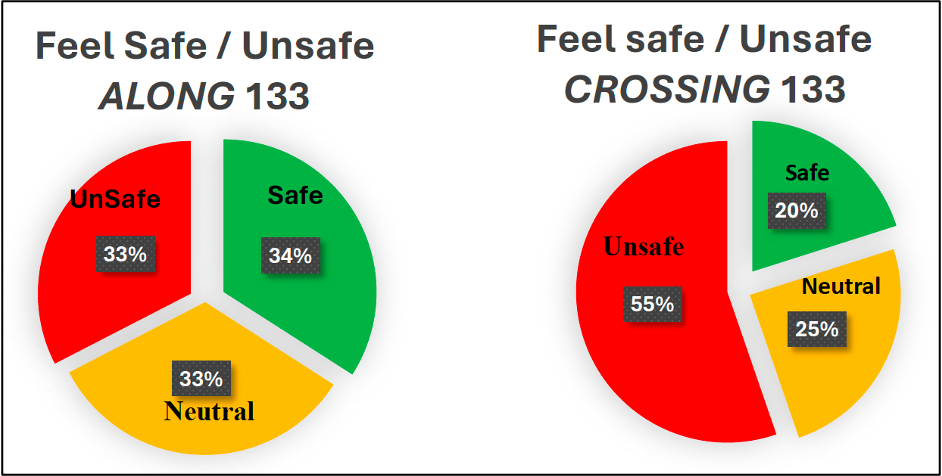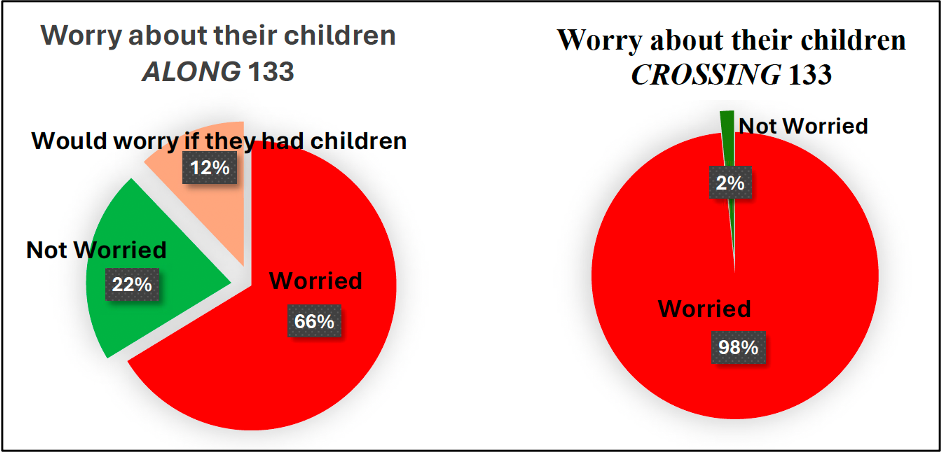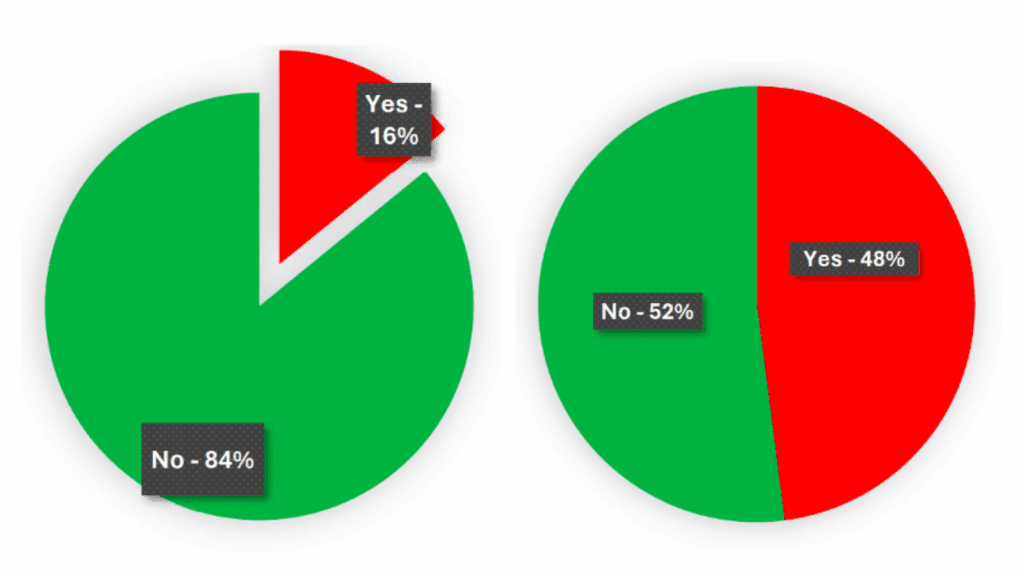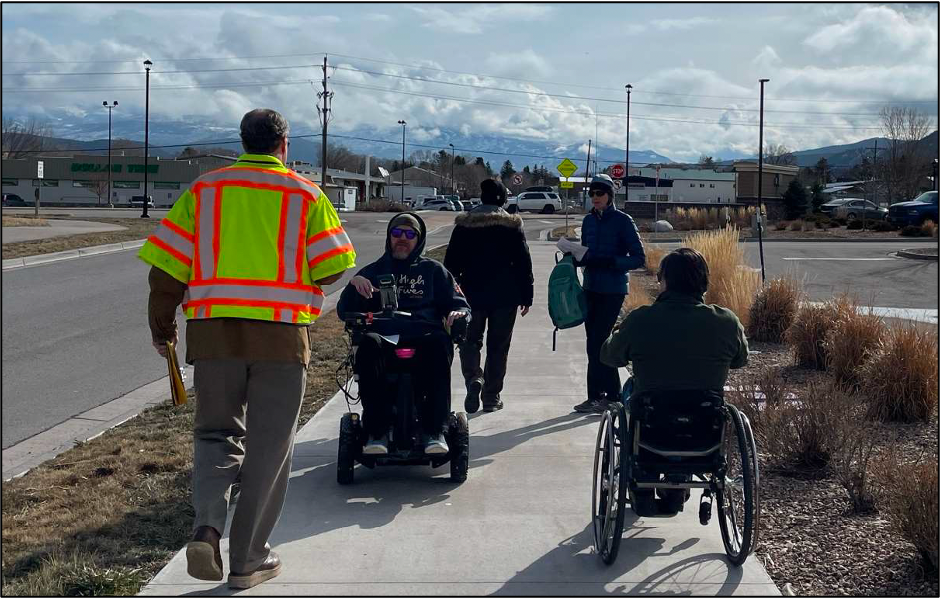Walking College fellows celebrate achieving their vision of a safe highway after three years of work. What can we learn from their success?

In 2022, Niki Delson and Sue Zislis with the grassroots group Age-Friendly Carbondale (AFC) completed the Colorado State Walking College. The six-month intensive fellowship program, presented by America Walks and AARP Livable Communities, is designed to expand the capacity of local walkability advocates to enact policy and infrastructure improvements in their communities.
When developing a vision statement for their hometown of Carbondale, Colorado, Niki and Sue decided to focus on State Highway 133, which cuts through the heart of the small town. Their vision statement was: “Highway 133 will… become an aesthetically pleasing corridor that is safe for cyclists, pedestrians, and vehicular traffic.“
A Vision for Safer Walkability Along a Carbondale Highway
With fewer than 7,000 residents, Carbondale is nestled high in the mountains of Western Colorado. Highway 133 divides Carbondale lengthwise. The highway has always been a barrier, but it has grown from an inconvenience to a serious safety concern as new development has led to increased traffic volumes and higher vehicle speeds.
In their Walking Action Plan, the final assignment of the Walking College, Niki and Sue defined their first goal: compiling evidence of current and potential future challenges for cyclists and pedestrians crossing the highway. Niki and Sue presented their action plan to the AFC Board of Directors to ask that they take on ownership of the project. AFC is a volunteer 501(c)(3) organization led by older adults. AFC’s vision is to replace the outdated notion of older adults as being dependent on community resources with a new narrative that values their wisdom, experience, and leadership as essential for a thriving community. The AFC board enthusiastically endorsed the plan.
Throughout 2023 and early 2024, the AFC team consulted with a volunteer urban planner to conduct a broad community survey. The team employed multiple engagement strategies to reach residents where they live, work, and gather, including online and print surveys in English and Spanish. They also visited senior lunches, bike shops, school events, farmers markets, and other community events.
The survey reached more than 500 residents and collected data and testimonies about the harm the highway has caused and the need for more crosswalks and reduced vehicle speeds. They published the survey results and conclusions in the Highway 133: Dangerous as Designed – Carbondale Speaks Out report (see additional resources).

ideas for improving the highway for pedestrians and bicyclists
Niki, Sue, and other AFC volunteers made traffic safety a hot topic in the community by attending public meetings, sharing the survey results with residents and the media, and making presentations to the Town of Carbondale and the Colorado Department of Transportation (CDOT).
The pressure campaign finally paid off. In summer of 2025 the Sopris Sun newspaper reported that “Age-Friendly Carbondale’s ‘Dangerous as Designed’ surveys identified the need for pedestrian crossings along Highway 133. Two permanent crosswalks will be installed… one at City Market and another at Ross Montessori.”
While this campaign is one of many Walking College success stories, Niki and Sue thoroughly documented their progress and shared regular updates with America Walks, providing detailed data for an analysis of the keys to their success. They hope that these best practices can help other advocates for walkable communities in their own efforts.
Key #1: Prepare for Challenges
In their Walking Action Plan, Niki and Sue anticipated potential challenges in implementation and ways to overcome them.
They were concerned about being unable to build support among the general public and business community, as well as difficulties involved in partnering with CDOT. State departments of transportation are notoriously reluctant to engage with community members. Since CDOT owns Highway 133, the project relied on CDOT’s support to succeed.
When preparing to approach CDOT, the AFC team studied numerous plans and policies. They took note of statements such as, “pedestrian access, accommodation, and safety should be given full consideration during all project planning, scoping, and design,” as well as references to legal requirements related to the Americans with Disabilities Act.
Key #2: Look for Commitments Made in Existing Documents
During their research, AFC team members also combed through the Town of Carbondale’s documents They discovered the following statement in the 2013 Comprehensive Plan:
“Because the ability to get around without using a personal automobile is paramount, multimodal mobility is central to many of the Comprehensive Plan strategies and is a critical element of quality of life and a sustainable future. The multi-modal mobility element of the Comprehensive Plan centers around a network of priority multi-modal corridors that are planned to become the focus of future sidewalks, pathways, highway crossings, and other bike and pedestrian improvements.”
Written a decade earlier, the Town’s Comprehensive Plan also specifically mentions the need for safe crossings on Highway 133 to connect neighborhoods, promote accessibility, and create safe routes to school. Additionally, CDOT’s Vulnerable Road User Safety Assessment Guide states that “we need to identify the conditions in which crashes are more likely to occur and work towards preventing them before they happen.”
Neither CDOT nor the Town has followed through on these commitments.
The AFC team brought these oversights to CDOT and the Town’s Board of Trustees to spur collaborative conversation.
Key #3: Invest in Relationships with Public Officials
Prior to applying for a Walking College Fellowship in 2022, Niki served on the Town of Carbondale’s all-volunteer Bicycle, Pedestrian, and Trails Commission.
There, Niki learned the nuts and bolts of public policy and developed relationships with Town officials. When the town’s Public Works Director Kevin Schorzman told the commission that his staff did not have the time or capacity to survey sidewalks for pedestrian hazards, AFC volunteers stepped up to conduct walk audits of all the Priority Corridors in town. They also reported hundreds of necessary repairs. Niki and Kevin discuss the success of this relationship in AARP’s Benefits of Walkable Streets for All Ages webinar.
Years later, Kevin’s credibility with CDOT and his vocal support for safe pedestrian crossings on Highway 133 helped convince the agency to take the community’s concerns seriously.
Importantly, the AFC project team did not make demands of town staff. They framed their messaging around public safety issues, community concerns, and opportunities to work together. This approach was critical in facilitating a partnership during which elected officials became allies.
Key #4: Maximize Impact with an “Inside/Outside” Strategy
Local advocacy movements often succeed or fail based on spheres of influence.
As an independent grassroots organization, AFC is free to engage in unrestricted policy advocacy, but its access to policymakers is limited.
The Carbondale Bicycle, Pedestrian, and Trails Commission, on the other hand, is an official local government advisory body that makes formal recommendations to the Town Board of Trustees to encourage walking and biking, and to expand safe infrastructure. The commission cannot, however, organize community residents to advocate for a certain decision or criticize the Town.
By complementing each other’s strengths and weaknesses, AFC and the commission were able to collaboratively influence public policy decisions.
Key #5: Use the Language of Official Statements When Gathering Community Input
The CDOT’s Vulnerable Road User Safety Assessment Guide asserts that “people should be able to use the roads without fear of being injured or killed.” But when the AFC team asked Carbondale residents whether they feel safe walking along or across Highway 133, many reported they did not.


Only one-third of respondents reported that they feel safe walking the highway, and just one-fifth feel safe crossing. When asked whether Highway 133 is a safe place for children walking to school, responses were overwhelmingly negative. Two-thirds worried about their children walking along the highway, and 98% worried about children crossing.
These results demonstrate that current conditions do not meet CDOT’s standards and that safety improvements are necessary.
Key #6: Gather Data on “Close Calls” and Actual Crashes
While most traffic crashes that involve fatalities, injuries, and/or vehicle damage end up in public records, it is much harder to obtain reliable information on how often people are almost struck by vehicles.

75 respondents (16%) to the AFC team’s survey reported they had been involved in or witnessed a crash on Highway 133 (this number does not necessarily indicate 75 individual crashes). 222 respondents (nearly half) reported experiencing or witnessing close calls.
Close-call crash data added important context for the safety project and demonstrated the need for better infrastructure.
Key #7: Give Policymakers the Lived Experience of Their Decisions
The most impactful strategy of the campaign was inviting CDOT officials to join a walk audit of the Highway 133 corridor.
Transportation and planning professionals with local and state agencies often decline or ignore such invitations, but Traffic Operations Engineer William Crawford with CDOT’s Region 3 Office participated. The campaign team also invited two of Carbondale’s residents who are dependent on assistive devices for mobility to join them on the walk audit.

During the audit, Crawford spoke with these residents and observed several of the challenges people with disabilities face daily on the corridor. He observed that the long distance (0.7 miles) between legal crossings at Village Road and Main Street creates medical safety issues, including prolonged sun exposure, increased risk of power mobility device batteries running out, and repetitive strain injuries for those with manual wheelchairs.
As a result, many Carbondale residents with disabilities choose to cross Highway 133 outside of crosswalks, where they are at significant risk of being hit by a speeding vehicle.
The success of AFC’s campaign proves that transformational change at the community level is possible provided that project teams are prepared for bureaucratic challenges and willing to build relationships with local agencies.
Additional Resources:
- The Benefits of Walkable Streets for All Ages — AARP webinar recording, featuring Niki Delson and Kevin Schorzman, 2023
- Age-Friendly Carbondale Determined to Improve 133 Safety (The Sopris Sun, May 2024)
- Carbondale Solicits Input Regarding Temporary Traffic Features (The Sopris Sun, July 2025)
- Press Release: Nieslanik Ave Pedestrian Crossing is Now Open (Town of Carbondale, 2025)